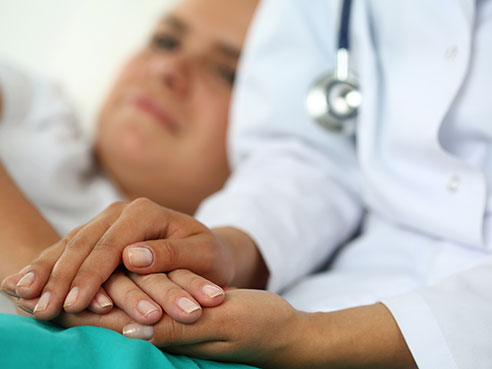 “A much smaller percentage of adolescents and young adults with cancer are treated at specialized cancer centers than children with cancer. We wanted to understand whether this difference in the site of cancer care is associated with the difference in survival outcomes.”Adolescents and young adults with acute lymphoblastic leukemia and acute myeloid leukemia treated at specialized cancer centers have significantly higher survival rates than their peers who are not treated at specialized cancer centers, according to a recent study from the University of Alabama at Birmingham, published in Cancer Epidemiology, Biomarkers & Prevention, a journal of the American Association for Cancer Research.
“A much smaller percentage of adolescents and young adults with cancer are treated at specialized cancer centers than children with cancer. We wanted to understand whether this difference in the site of cancer care is associated with the difference in survival outcomes.”Adolescents and young adults with acute lymphoblastic leukemia and acute myeloid leukemia treated at specialized cancer centers have significantly higher survival rates than their peers who are not treated at specialized cancer centers, according to a recent study from the University of Alabama at Birmingham, published in Cancer Epidemiology, Biomarkers & Prevention, a journal of the American Association for Cancer Research.
Investigators from the UAB Institute for Cancer Outcomes and Survivorship compared survival rates of the two groups of patients with ALL and AML being treated at specialized cancer centers, those who hold a designation by the National Cancer Institute as either a Comprehensive Cancer Center or Children’s Oncology Group site, to children with ALL and AML. Adolescents and young adults, ages 15 to 39, diagnosed with ALL from ages 15 to 29 or AML from ages 15 to 21 who were treated at specialized cancer centers had better outcomes than those who were not treated at specialized cancer centers as compared to children with ALL or AML.
The UAB Comprehensive Cancer Center is one of only 45 NCI-designated “comprehensive” cancer centers in the United States, and the only one in Alabama and the Deep South region. The Cancer Center undergoes a rigorous review process and is evaluated based on the quality of its multidisciplinary science and how that care is brought into the clinic. For many, an NCI designation can hold the key to survival, in that it brings the best, most innovative care to the patient. Many studies have already been done to support that conclusion.
“Adolescents and young adults with ALL and AML have significantly worse survival outcomes compared with children ages 14 and under,” said Julie Wolfson, M.D., assistant professor in the UAB Division of Pediatric Hematology-Oncology. “A much smaller percentage of adolescents and young adults with cancer are treated at specialized cancer centers than children with cancer. We wanted to understand whether this difference in the site of cancer care is associated with the difference in survival outcomes.”
Data from the Los Angeles County Cancer Surveillance project was used to identify patients ages 1 to 39 with ALL or AML. The study included 1,870 patients diagnosed with ALL or AML. Of the 402 adolescents and young adults diagnosed with ALL, 30 percent received care from a specialized cancer center, compared to 70 percent of those patients diagnosed with ALL during childhood. Of the 359 patients diagnosed with AML in young adulthood, 22 percent were treated at a specialized cancer center, compared to 74 percent of children diagnosed with AML.
| The study found that adolescents and young adults diagnosed with ALL between the ages of 15 and 29, or with AML between the ages of 15 and 21, who were not treated at a specialized cancer center had a two times higher risk of death as compared to children with acute leukemia. |
The study found that adolescents and young adults diagnosed with ALL between the ages of 15 and 29, or with AML between the ages of 15 and 21,who were not treated at a specialized cancer center had a two times higher risk of death as compared to children with acute leukemia. Those diagnosed with ALL between the ages of 30 and 39, or diagnosed with AML between the ages of 22 and 39, were at an increased risk of dying as compared to children with acute leukemia, no matter where they received care.
Adolescents and young adults ages 15 to 29 with ALL who were treated at specialized cancer centers, like the UAB Comprehensive Cancer Center, had comparable survival rates to children ages 10 to 14 treated at specialized cancer centers. Patients with AML ages 15 to 21 who were treated at specialized cancer centers had comparable survival rates to children ages 1 to 14 treated at specialized cancer centers.
“The fact that the oldest adolescents and young adults did not appear to benefit from treatment at a specialized cancer center suggests to us that the biology of the disease in these patients differs from that in younger individuals,” Wolfson said. “The most important thing we can do to help these patients is to enroll them in clinical trials so that we can better understand the biology of the disease and its response to therapy.”
Adolescents and young adults ages 22 to 39 who were uninsured or publicly insured were 70 percent less likely to be treated at a specialized cancer center compared with those who had private health insurance.
Since the data were obtained from a cancer registry, detailed information about each patient’s treatment regimen or the features of his or her disease present limitations of the study. The study was supported by grants from the National Institutes of Health and the St. Baldrick’s Foundation.